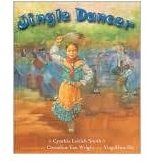Celebrate November, National American Indian Heritage Month, With "Jingle Dancer:" Elementary Grades Social Studies
This beautifully written and illustrated book, Jingle Dancer by Cynthia Leitich Smith, melds the modern life of a young girl with the customs of her Native American ancestors. The book provides information about Jingle Dancers and also shows how a young girl brings grace and
honor to the strong women in her family. Reading and discussing this book is a wonderful way to celebrate November as National American Indian Heritage Month.
Jenna daydreams about being part of the dance that she has watched her grandmother perform at many powwows. Jingle dances are done by women and girls of most Native Nations and are often done for prayer and healing. She longs to have enough jingles for her own dress but it is too late to order any. When visiting her female relatives, Jenna asks for a small amount of jingles from each of their dresses, never wanting to have a dress “lose its voice” by taking them all. Will she gather enough to allow her dress to sing?
Examine a Literary Device: Personification
Discuss the author’s descriptions with the students. What seems different about the way she makes the reader feel about the dresses? How does she seem to refer to the sun and moon?
Personification is a writing device that gives human qualities to something nonhuman.
Personification is used effectively in this book to make us feel as if the dresses take on a human quality: “Now Jenna’s dress could sing.” and “She did not want to take so many jingles that the dress would lose its voice.”
Another example of personification is when the author describes the transition between day and night: “As Moon kissed Sun good night.” and “As Sun fetched morning…” The words sun and moon are even capitalized, as names would be. Native Americans believed that the sun, moon, thunder, and so on took on human form. Legends were told about them.
Let’s Look at Jenna
Think of reasons why we admire Jenna. Would she be a good friend?
1. She continues to practice the dance not knowing if she will be able to have enough jingles for her dress.
2. She does not want to be greedy by asking for all the jingles from one person’s dress.
3. She willingly helps the women with chores while they visit.
4. She helps to sew jingles on her own dress.
5. She respects and honors her Native American heritage.
The Jingle Dance
Jenna is a descendant of the Ojibway Tribe. This tribe is believed to have begun the tradition of the Jingle Dancers as a form of healing and prayer. Jingles are often made from aluminum or silver lids and rolled into cones. The cones are sewn onto the fabric of the dresses or on ribbons, which are later attached to the dresses. The sounds they make when tapping each other has been compared to the sound of rain. The dance is often performed at powwows which are similar to festivals but frequently have a spiritual theme. The event includes food, music and the telling of stories and involves many Nations of American Indians.
Here is a link for you to use with your students to show how the dance is done. Click here.
Heritage
For children to embrace their heritage is a wonderful thing. They learn about history and the cultural habits of their ancestors. Celebrating our individual heritage in the classroom can prove to be fascinating for all involved. The more we know about our differences and similarities the more tolerant we become. Jingle Dancer is just one of many books to help you promote the pride of heritage within your students.
Resource:
